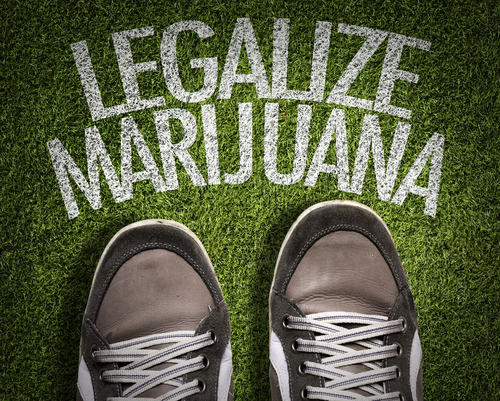readying to legalize recreational cannabis on Oct. 17, becoming the first industrialized country in the world to do so. When legal for adult-use purchase and consumption, Canada’s legal weed industry could generate in excess of $5 billion in annual sales.
To our south, Mexico legalized medical marijuana in June 2017. While medical weed isn’t nearly the same behemoth that recreational pot is, it’s still a new means to generate high margins by companies involved in the industry.
Two steps forward…two steps back
Then there’s the United States. Within the U.S., 30 states have given the green light to medical marijuana, including the Republican-leaning state of Oklahoma. Republicans traditionally have a much more negative view of cannabis than do Democrats or Independents. A national Gallup poll from October 2017 also found that an all-time record 64% of Americans favor the idea of legalization. It would appear that the United States is motoring toward legalization — and yet it’s not.
At the federal level, marijuana remains a Schedule I drug. By definition, this means it’s wholly illegal, prone to abuse, and has no recognized medical benefits. Despite a rising tide of momentum for state-level legalizations, there’s been virtually no movement on the part of the federal government when it comes to weed. The one exception is that the federal government will ramp up approved medical marijuana production in 2019 for medical research purposes.
As you can imagine, cannabis remaining a Schedule I drug isn’t optimal for the industry, in spite of state-level approvals. For instance, marijuana companies are having difficulty getting access to basic banking services, such as loans, lines of credit, and even checking accounts. This lack of easy access to capital can make expanding a business incredibly tough.
The other major issue is Section 280E of the U.S. tax code. This more-than-three-decade-old component of the tax code is what’s behind what would be a major Catch-22 if the federal government ever caved in to the will of the American public and considered legalization.
The U.S. is facing one heck of a Catch-22 if it ever tries to legalize weed
Section 280E of the U.S. tax code was introduced in 1982 following a 1981 court case of a convicted cocaine trafficker who asserted his right to take normal business deductions on his federal income taxes. In short, 280E disallows businesses that sell a Schedule I or II substance from taking normal corporate income tax deductions, save for cost of goods. Without these additional deductions, profitable U.S.-based pot businesses could be looking at an effective tax rate of as much as 70% to 90%, which isn’t very conducive to growth.
Here’s where things get tricky. Despite their being illegal at the federal level, the federal government has no issue collecting income tax on state-level marijuana companies. The fact that no deductions can be taken by businesses selling pot ensures that the federal government receives a good amount of corporate income-tax revenue each year.
However, if the federal government removed marijuana as a controlled substance, it would no longer be subject to 280E. If marijuana businesses were thus allowed to take normal business deductions, it’s estimated that the federal government would lose about $5 billion in revenueover the next decade – and with the federal government still running a hefty annual budget deficit, reducing revenue isn’t exactly optimal. Thus, on one hand, the federal government has no financial incentive to change the way things are now.
But let’s, hypothetically, say that the federal government would be willing to compromise on cannabis with a higher tax rate. If Congress can be assured that revenue wouldn’t decline, or better yet would increase, then they’d probably be more likely to give a bill supporting legalization a green light.
Now, here’s the problem: the U.S. (and every other marijuana market for that matter) is contending with a very large black market that comprised more than 85% of aggregate weed sales throughout North America in 2016. The black market has virtually no overhead costs, since it doesn’t need to pay corporate income tax, rent for a brick-and-mortar space, or purchase cultivation and/or sales permits. This means the black market can undercut legal channels on price from the get-go. If taxes associated with the sale of cannabis, or the corporate income-tax structure, are lifted in order to bring in more money to the federal government, it could negatively impact legal-channel sales and push them back into the black market.
This is going to be a challenge in Canada, which is implementing a reasonably low excise tax rate on recreational weed sales of roughly 10%. Even with Canada attempting to root out the black market by keeping the tax rate on sales low — comparatively, alcohol sales in Canada come with a frothy 50% to 80% excise tax rate — the black market can still undercut legal channels with ease. It’s unclear how effective Canada’s strategy will prove.
Plenty of incentive to legalize
Clearly, there are a lot of major kinks to work through if the U.S. ever moves to legalize. No matter what it does, there could be adverse ramifications on the industry, as well as for investors. Nevertheless, there are clear incentives for the federal government to at least consider the move.
For starters, there’s already a cannabis conundrum on the table. On June 25, the U.S. Food and Drug Administration (FDA) approved GW Pharmaceuticals‘ (NASDAQ:GWPH) Epidiolex as a treatment for two rare forms of childhood-onset epilepsy. GW Pharmaceuticals’ lead drug is cannabidiol (CBD) based (CBD is the nonpsychoactive component of the cannabis plant best known for its perceived medical benefits), meaning it became the first cannabis-derived drug to gain approval from the FDA. Since Schedule I drugs are, by definition, devoid of any medical benefits, and the FDA has recently shown otherwise with Epidiolex, it creates a conundrum that could entice a closer review of marijuana in the United States.
Marijuana is also a big-money business. If the U.S. were to legalize recreational weed, it would easily be the most lucrative market for weed in the world. Aside from simply local, state, and federal tax dollars, we’d likely be talking about a lot of job creation, as well as benefits that would trickle down to ancillary businesses that help support the needs of companies that directly come into contact with the cannabis plant.
And, as noted, a majority of the American public wants to see pot legalized. If anything, even if adult-use marijuana isn’t on the table, the public overwhelmingly supports giving medical marijuana the thumbs-up. The independent Quinnipiac University found that 93% of respondents were in favor of the idea of a physician being able to prescribe medical pot as of April 2018.
Things are definitely trending toward change in the U.S., but it won’t necessarily be an instant win for the federal government, the industry, or marijuana stock investors if the substance is legalized.
(311)





Leave A Reply